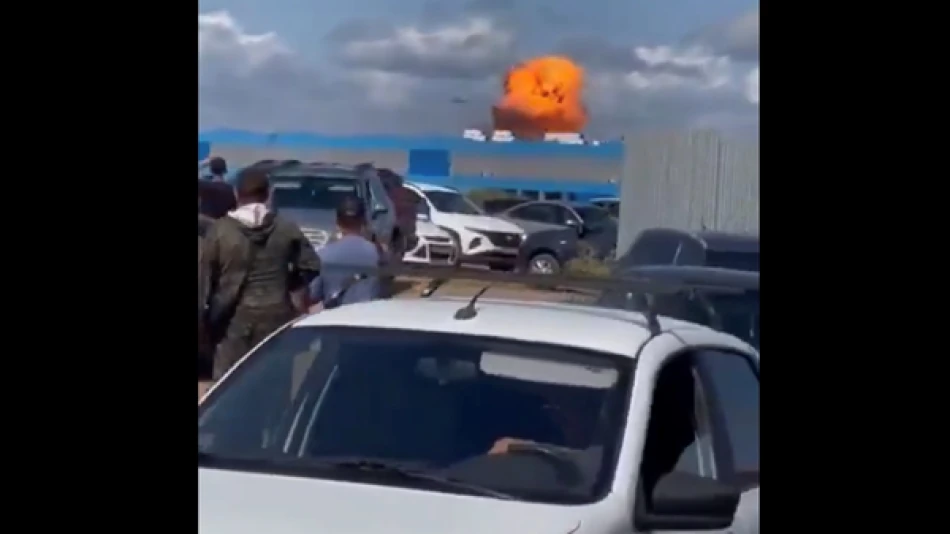
Ukraine Strikes Russian Drone Storage Facility, Disrupting Aerial Reconnaissance
Ukraine Escalates Deep-Strike Campaign with 1,300km Drone Attack on Russian Tatarstan
Ukraine's security service has successfully struck a drone storage facility deep inside Russian territory in Tatarstan, marking a significant escalation in Kyiv's long-range capabilities. The 1,300-kilometer strike represents one of the furthest Ukrainian attacks from the border, signaling a strategic shift toward targeting Russia's military infrastructure at unprecedented distances.
The Tatarstan Strike: A New Milestone
On Saturday morning, Ukrainian Security Service (SBU) drones hit a logistics center storing ready-to-use drones and components in Russia's Tatarstan Republic. Video footage released by the SBU shows the moment of impact, followed by explosions and fires engulfing the facility.
The attack was carried out by long-range drones from the Special Operations Center "A," part of Ukraine's Special Operations Support Unit. The successful strike demonstrates Ukraine's growing ability to project power far beyond its borders, reaching targets previously considered safe from Ukrainian retaliation.
Strategic Implications of Deep-Strike Operations
Breaking Russia's Sanctuary Zones
The 1,300-kilometer range puts virtually all of European Russia within Ukrainian striking distance, fundamentally altering the conflict's geography. Tatarstan, located in the heart of Russia, was previously considered a secure rear area for military logistics and production.
This capability forces Russia to redistribute air defense systems across a much wider territory, potentially weakening protection for critical infrastructure and military assets closer to the front lines. The psychological impact cannot be understated—no Russian military facility can now consider itself beyond Ukrainian reach.
Targeting the Drone War's Supply Chain
Ukraine's focus on drone storage and production facilities reflects a sophisticated understanding of modern warfare logistics. By striking where drones are stored and assembled rather than just intercepting them in flight, Ukraine aims to disrupt Russia's drone campaign at its source.
The timing is particularly significant as both sides have increasingly relied on unmanned systems for reconnaissance, targeting, and direct attacks. Russia's drone strikes on Ukrainian civilian infrastructure have been a defining feature of the conflict's recent phase.
Pattern of Escalating Long-Range Operations
The Tatarstan attack follows a series of deep-strike operations that demonstrate Ukraine's expanding capabilities. Just days earlier, on August 2nd, Ukrainian drones simultaneously hit an airport used for drone operations in Krasnodar region's Primorsko-Akhtarsk and the Elektropribor military plant in Penza.
This coordinated approach suggests Ukraine has developed both the technical means and operational sophistication to conduct complex, multi-target missions deep inside Russian territory. The attacks appear designed to systematically degrade Russia's drone warfare infrastructure rather than achieve symbolic victories.
Technological and Tactical Evolution
Ukraine's success in conducting strikes at such distances indicates significant advances in drone technology, navigation systems, and operational planning. These capabilities likely combine domestically developed systems with adapted commercial technologies and possible intelligence support from Western allies.
The ability to coordinate multiple long-range strikes suggests Ukraine has overcome major technical challenges in communication, navigation, and target identification across vast distances. This represents a qualitative shift from the primarily defensive drone operations that characterized earlier phases of the conflict.
Broader Conflict Implications
These deep-strike capabilities fundamentally alter the conflict's strategic balance. Russia can no longer assume its military-industrial infrastructure is safe simply by virtue of distance from the front lines. This forces a costly redistribution of defensive resources and potentially impacts production and logistics chains throughout Russia.
For Ukraine, demonstrating the ability to strike deep into Russian territory serves both military and diplomatic purposes. It shows continued resilience and growing capabilities while potentially influencing international perceptions of the conflict's trajectory and Ukraine's long-term viability.
 Layla Al Mansoori
Layla Al Mansoori







